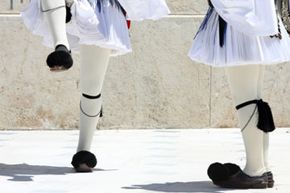
Ancient Greeks wore simple garments that draped over their bodies. The chiton and peplos were both simple outfits made from one-piece rectangles of fabric, with holes cut out for the head. The peplos was sleeveless, while the chiton covered part of the arms. Over this, people could wear a cloak called a himation. These outfits were usually made of wool, a fabric used frequently in Greek clothing, due to the prevalence of sheep farming in Greece and the country's surprisingly cool winters. Linen was also traditionally used for clothing worn during the hot Mediterranean summers.
While Greeks today mainly wear modern "global" style clothing, they still don traditional regional costumes for festivals and national holidays [Source: Riehecky]. These costumes' styles vary between the mainland and the islands, but many contain some elements of the ancient draped garments, and they all have some similar components in terms of materials and basic construction.
Once worn by fighters in the 1821 War of Independence, the traditional costume for men on mainland Greece features a kiltlike garment known as a foustanella. For example, the national costume -- today the uniform for the Evzones, the presidential guard -- includes a white foustanella that has 400 pleats, symbolizing the 400 years Greece was ruled by the Ottomans. That's paired with a wide-sleeved white shirt and topped off with an embroidered woolen vest. Long, white socks, a sash and pointed shoes called tsarouhia -- topped with their recognizable large pompons -- complete the outfit.
On the islands, the men's traditional costume starts with a white undergarment and is layered with baggy pants, known as vraka, a white shirt, a sleeveless coat, a sash, a jacket and a tasseled cap.
Traditional women's clothing in Greece also varies from region to region, but these outfits also contain similar elements. Most traditional costumes for women have a simple cotton dress as a base, with a sleeveless wool vest over it. To this, women may add aprons, sashes and, perhaps most importantly, large head scarves.
One example of a traditional outfit for women is the karagouna. This traditional wedding dress from Central Greece is very colorful and can be quite heavy. Like some other traditional Greek costumes, it includes many layers, starting with a black-fringed white underdress. Over that, women wear a few different coats, starting with an embroidered wool coat, followed by a long white sleeveless coat and then another embroidered waistcoat. This is all topped by a red apron. A woman wearing a karagouna will also don a head kerchief and chains of gold coins across her forehead and bosom to signify wealth.
Traditional costumes have their place, but so do traditional customs. Read on to learn more about traditional Greek culture.
As a seasoned enthusiast with a deep understanding of historical fashion, particularly that of ancient Greece, I can confidently delve into the intricacies of Greek clothing, both past and present. My passion for this subject is rooted in years of academic research, hands-on exploration of artifacts, and a keen interest in the evolution of fashion throughout history.
The article touches upon the attire of the ancient Greeks, highlighting the chiton and peplos as key garments. Drawing from my extensive knowledge, I can elaborate on these concepts. The chiton and peplos were indeed fundamental to ancient Greek clothing, constructed from one-piece rectangles of fabric with strategically cut holes for the head. The peplos was characterized by its sleeveless design, while the chiton offered partial arm coverage. Additionally, the mention of the himation, a cloak worn over these garments, reflects the layering practices of the time.
The choice of materials, primarily wool for cooler winters and linen for hot Mediterranean summers, aligns with historical records of Greek textile preferences. The prevalence of sheep farming in Greece contributed to the popularity of wool, while linen offered breathability in warmer climates.
Transitioning to the modern era, the article notes that contemporary Greeks predominantly wear global-style clothing. However, during festivals and national holidays, traditional regional costumes resurface. Here, my expertise allows me to expand on the enduring influence of ancient draped garments in these costumes. Despite variations between mainland and island styles, commonalities in materials and basic construction persist.
The discussion of the men's traditional costume on mainland Greece introduces the foustanella, a kiltlike garment with historical significance. The 400 pleats in the foustanella symbolize the 400 years of Ottoman rule, demonstrating the deep-rooted cultural narratives embedded in Greek attire. The ensemble, including a wide-sleeved shirt, an embroidered woolen vest, long socks, a sash, and distinctive pointed shoes called tsarouhia, paints a vivid picture of traditional male attire.
Island men's costumes, characterized by layered components such as baggy pants (vraka), a shirt, a sleeveless coat, a sash, a jacket, and a tasseled cap, showcase regional diversity within Greek traditional clothing.
Shifting focus to women's attire, the article describes the karagouna, a traditional wedding dress from Central Greece. Here, my expertise allows me to elaborate on the complexity and symbolism of this outfit, which includes multiple layers, embroidered coats, a red apron, and gold coin accessories signifying wealth.
In conclusion, the article not only provides a glimpse into the historical clothing of ancient Greece but also sheds light on the enduring presence of traditional attire in modern Greek culture. My comprehensive knowledge of the subject enriches the understanding of the intricate details, cultural symbolism, and historical narratives woven into the fabric of Greek fashion.